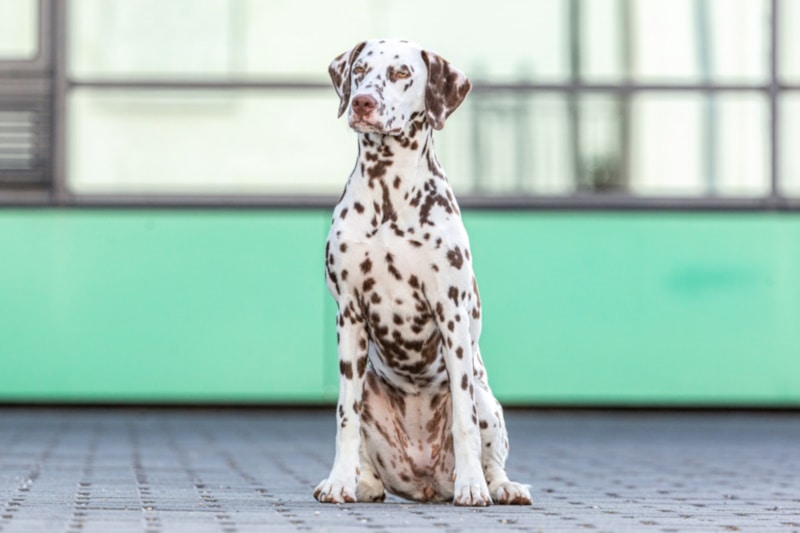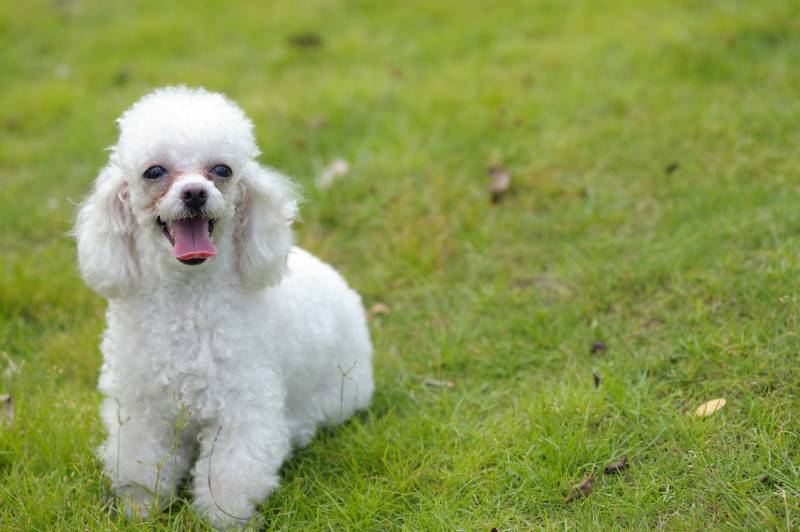Why Does My Dog Bark at Thunder? 9 Reasons & Vet Reviewed Prevention Tips
Updated on
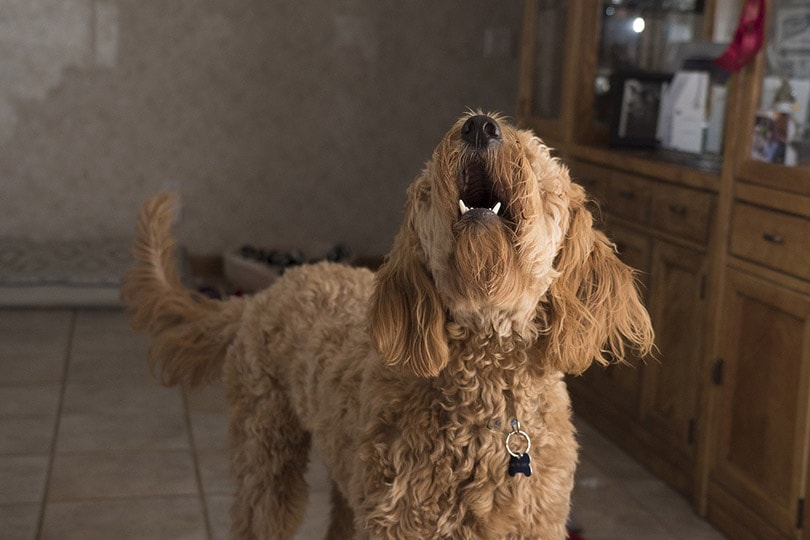
You’re relaxing on the couch with your dog and watching TV when you hear it: the rumbling growl of thunder in the distance. Pretty soon, your dog is barking, shaking, and trying to hide.
The second your dog hears the booming sound outside, you know you’re in for a wild night. Unfortunately, many dogs don’t like thunderstorms, and some panic to the point of destruction.
It’s always sad to see our precious pups so scared. But how can you help them? It helps to get to the root of the problem first. This post discusses possible reasons that your dog is barking at thunder and tips for stopping the behavior.
The 9 Possible Reasons That Dogs Bark at Thunder:
1. Fear
Many dogs experience thunderstorm phobia. The unpredictable, windowpane-rattling booms from thunderstorms make most dogs run for the hills. Even some wild animals fear thunderstorms.
Although this is normal dog behavior, it’s still heartbreaking to see your pup scared, especially when the fear causes physical destruction. Sometimes the fear is apparent, and other times it’s less obvious. Here are some signs that your dog is scared of a storm:
- Panting
- Pacing
- Whining
- Salivating
- Tucked tail
- Flattened ears
- Trembling
- Inappropriate urination or defecation
- Digging
- Chewing
- Running away
- Staying close to an owner
- Attacking other dogs
2. Anxiety
A lot of us can relate to feeling anxious during a thunderstorm. Anxiety is a reaction to our emotions, whereas fear is a reaction to what is happening.
Basically, anxiety likes to piggyback into our minds through fear. Dogs are no exception. Anytime fear sets in, dogs become anxious because they know something terrible will happen.
We often see separation anxiety in dogs, but thunderstorms are another major contributor. The signs of anxiety are the same signs as fear, so keep an eye out for them.
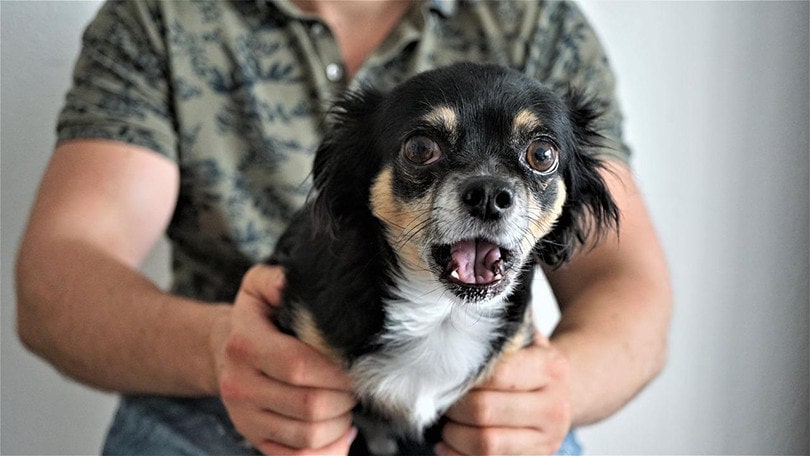
3. Past Experiences
Barking at thunder could be your dog’s response to a bad past experience. Maybe your dog lived in a home where a storm made a tree fall on a roof, or your dog was found wandering a field during a storm.
These experiences probably taught your dog that trouble is afoot during storms, especially if your dog was 8–16 weeks old when these scenarios occurred.
Unfortunately, some dogs generalize their past experiences with thunderstorms to include any event that includes rain or high winds. The goal of remedying this behavior is to turn a bad past experience into a good one. This will be tricky, but it’s not impossible.
4. Environmental Changes
Yes, dogs can, in a way, predict the weather! They can’t tell you what’s happening, but they can certainly sense the environmental change.
How is this possible? Dogs sense the barometric pressure drop and changes in the static electric field. They can do so with their heightened sense of smell and hearing. So, if the change in air pressure and electricity changes, dogs will know that a storm is potentially on its way.
Unfortunately, the only thing dogs can do is react to the storm and hope their owners pick up on the signals.

5. Noise
Have you ever noticed your dog barking at what appears to be nothing? Maybe your dog isn’t scared of thunder. Instead, your dog could be barking because they hear some sort of noise that you might not be able to.
Dogs tend to bark at anything they feel threatened by. That doesn’t mean they’re scared. It just means they need to assert their dominance. Dogs also don’t know where the noise is coming from, so it could be that your dog is giving mother nature a warning.
6. Competition
Dogs are hilariously competitive and will try to one-up the thunder by barking. If this is the case, your dog isn’t scared of the thunderstorm. Your dog just wants to show the thunder who’s boss!
Competition and noise can go hand in hand. However, dog competition tends to be louder and more aggressive.
You can approach the situation like you would leash aggression. For instance, if you and your dog pass a neighbor’s yard and their dog is out front barking, your dog will probably try to match that energy by barking and tugging on the leash.
Thunderstorms work in the same way for some dogs. Just be careful about opening doors because some dogs will escape while barking at the storm.
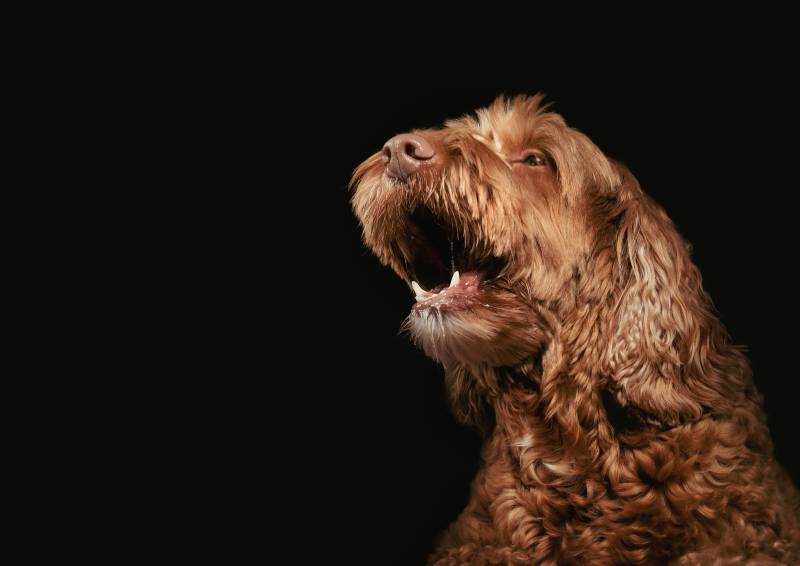
7. Mimicking Another Dog’s Behavior
This one is for multi-dog households. As you have probably noticed, dogs are like children. When one dog starts barking, the other dogs feel pressured to do the same. Pay attention to your dogs’ respective behaviors, and pick out which one is the instigator.
This scenario can be dangerous because a fearful dog can quickly attack another animal. So, keep an eye out, and prepare for fear-driven behavior ahead of time.
Alternatively, the dog could also be barking after hearing a neighbor’s dog.
8. Mimicking Your Behavior
Are you scared of thunderstorms? That’s okay! But your dog probably senses your fear and is responding to this emotion.
This power lies in their keen sense of smell. Like it or not, all humans emit a particular scent through our sweat glands when fear takes over our bodies. This is called a chemosignal. Dogs pick up on the smell and often unify with the emotion.
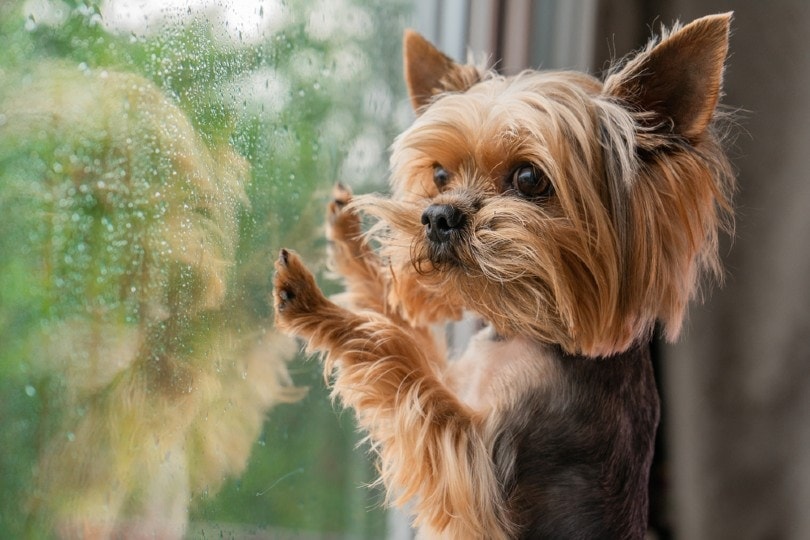
9. Genetics
Some studies suggest that genetics play a part in how an animal reacts to a situation, particularly fear. The idea is that a specific breed influences what a dog considers stressful. It could be related to the dog’s breed, or it could be because of the thousands of years of domestication. More research is needed to prove that genetics set the threshold for emotional response, but it is a theory to consider.
 How to Calm a Dog During a Thunderstorm
How to Calm a Dog During a Thunderstorm
You don’t want to ignore your dog during a storm. It will help your dog to know that you are there for support.
Sometimes storms catch us off guard, so we don’t have time to prepare. Pay attention to the forecast when you can. If there’s any chance for rain, be proactive and plan ahead. In any case, here are a few ways you can help your dog during any thunderstorm.
1. Safe Spaces
If your dog prefers to be left alone, make sure they have a safe space to retreat to. This can be a kennel, a bedroom, under the bed, or anywhere else where your dog feels safe. Your dog’s safe space could even be in your lap. If your dog prefers the kennel, drape a blanket over the kennel for comfort.
As a side note, don’t try to remove your dog from their safe space unless there’s a weather emergency.

2. Noise Reduction
It turns out that dogs enjoy Mozart as much as humans do. Dog calming music is quite popular and successful in helping anxious dogs. You can try other background noise to dilute the thunder, like playing the TV, radio, or even running the dryer. Anything to drown out the thunder is helpful for your dog.
An exciting new invention by Ford is the noise-canceling dog kennel. Ford uses the same technology in noise-canceling headphones to mitigate sounds or remove them altogether. The dog kennel is still in the beginning stages of development, but who knows? Maybe it’s something that will work for your dog.
3. Thundershirts
Kill two birds with one stone by comforting your dog and scoring some free cuddles. Additional help can come from a thundershirt, a concept of swaddling a highly anxious dog for comfort. You can also simplify this by using a blanket and holding your dog.
4. Calming Diffusers and Sprays
Adaptil is a great option for dogs that need help relaxing in challenging situations. Adaptil is a synthetic hormone produced by a mother dog to soothe her puppies. This option is a drug-free solution if you’re wary about starting your dog on anti-anxiety meds. You can find Adaptil as a calming spray and diffuser.

5. Medicine
This option should be a last resort. If your dog’s fear is uncontrollable, you may need to talk to your veterinarian about acalming prescription, like Trazodone. Keep in mind that animals react differently to medications, so if Trazodone doesn’t work, your veterinarian may suggest a different medicine.
CBD is another great option for a more natural approach. Dog owners report great success in relieving dog anxiety, specifically with noise reactivity. However, there aren’t any controlled studies to show its effectiveness yet.
Can Dogs Stay Outside During Thunderstorms?
Dogs should never be left outside during a thunderstorm. Your dog could escape the yard in a panic and get injured in the process. Your dog should have some dog ID tags on their collar for this very scenario, but you can avoid the stress by bringing them inside.
 Conclusion
Conclusion
Some dogs don’t mind thunderstorms and may jump at the occasional loud boom. Other dogs can’t stand the storm from the first raindrop. We understand how frustrating and heartbreaking it is to handle a dog that’s terrified of storms. If your dog is spooked by storms, try the above suggestions. They aren’t one-size-fits-all solutions, though, so get creative!
Remember, you can always talk to your veterinarian and behaviorist about stronger medicines if your dog is terrified of thunderstorms. We believe that there’s an answer for both of you.
Featured Image Credit: dahancoo, Pixabay



 Conclusion
Conclusion